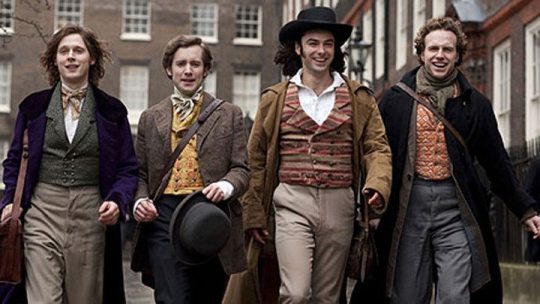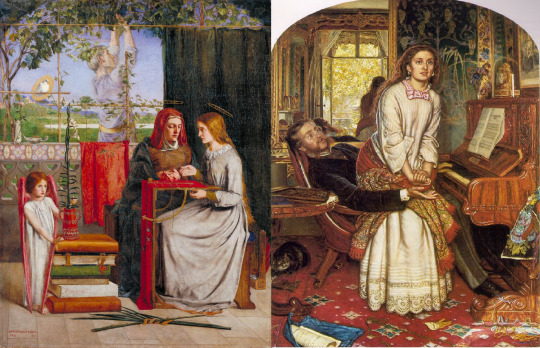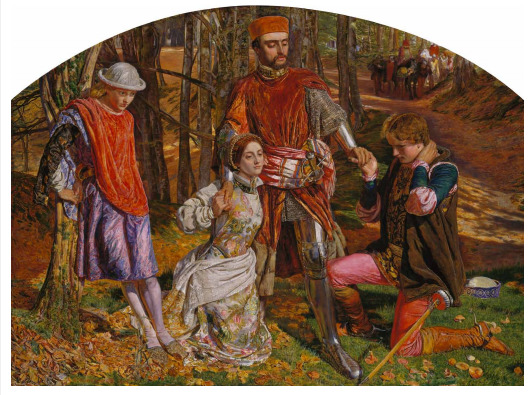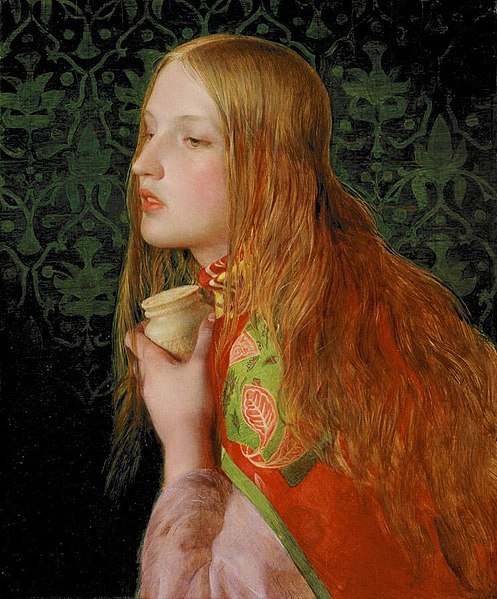Text
The Sisters is an c. 1860 oil painting illustrated by Victorian painter James Collinson, who was a Pre-Raphaelite Brotherhood member (1848 to 1850) from the mid-19th century.

3 notes
·
View notes
Text
And they were seven
It was decided that seven was the appropriate number for a rebellious group and four others were added to form the initial Brotherhood. The selection of additional members has long mystified art historians. James Collinson, a painter, seems to have been added due to his short-lived engagement to Rossetti’s sister Christina rather than his sympathy with the cause. Another member, Thomas Woolner, was a sculptor rather than a painter. The final two members, William Michael Rossetti and Frederic George Stephens, both of whom went on to become art critics, were not practicing artists. However, other young artists such as Walter Howell Deverell and Charles Collins embraced the ideals of the PRB even though they were never formally elected as members.
The Brotherhood was devided in:
Main Pre-Raphaelite Artists
Associated artists and figures
Loosely associated artists

Desperate Romantics – a 2009 TV series in England featured the rebellious, talented and charismatic young men known as the Pre-Raphaelite Brotherhood.
Publicity still portraying (left to right) Samuel Barnett as John Everett Millais, Sam Crane as Fred Walters, Aidan Turner as Dante Gabriel Rossetti, Rafe Spall as William Holman Hunt.
#pre raphaelite#pré rafaelita#pre raphaelism#desperate romantics#william holman hunt#john everett millais#dante gabriel rossetti
5 notes
·
View notes
Text
Heterogeneous
Although it is a group of artists united for the same purpose, the group has not shown itsel to be homogeneous in its productions.
(Millais, Holman Hunt) - They will devote themselves to the themes and problems of today's increasingly materialistic society, using for this a realistic representation.
(Rossetti, Edward Burne-Jones) - They Will connect more to medieval themes inspired by Dante, in his Divine Comedy, in legends such as that of King Artur, religious scenes, carrying compositions of mysticism in a more visionary version.
The core: It is essential that the work of art conveys an authentic idea, the result of the artist's individuality. Do not submit to rigid and castrating rules of representation, but rather be free in your artistic creation. Its art is going to oppose the traditional method of representation of nature, dispensing with Atelier's work and rejecting the normality of academic compositions (eliminating the horizon line).
Paintings:
1.The Girlhood of Mary Virgin (1849) by Dante Gabriel Rossetti.
2.The Awakening Conscience (1853) by William Holman Hunt.

#The Girlhood of Mary Virgin#The Awakening Conscience#william holman hunt#dante gabriel rossetti#pre raphaelism#pre raphaelite#religious painting
3 notes
·
View notes
Text
Opposing the Bitumen
The color application will break ties with traditional techniques, now appearing luminous, enamelled colors, which helped the aesthetic sensibility of poetical paintings where romance and eroticism are together with a critical innocence, have a prominent place.
The Pre-Raphaelite Brotherhood was greatly influeced by nature and it's members used great detail to show the natural using bright and sharp focus techniques on white canvas, In attempts to revive the brilliance (their emphasis on brilliant of colour was reaction to the excessive use of Bitumen by early British artists, Bitumen produces unstable areas of muddy darkness, an effect the PRB despised) of colour found in Quatroccento art, Hunt and Millais Developed a technique of painting in thin glazes of pigment over a wet white ground in the hope that the colours would retain jewel-like transparency and clarity.
This effect made the pure colours brushed over it seem illuminated. A vibrant early example of this effect is seen in Hunt's painting illustrating a scene from Shakespeare’s Two Gentlemen of Verona, in which the hero, Valentine, halts his friend Proteus’ unwanted advances toward Silvia, the woman they both desire. The brilliant colors and elaborate details of costume and vegetation still astonish today.
Painting: William Holman Hunt, Valentine Rescuing Sylvia from Proteus—Two Gentlemen of Verona (Act V, Scene iv), 1850–1851, oil on canvas, Birmingham Museums and Art Gallery, Purchased 1887.

#william holman hunt#pre raphaelite#pre raphaelism#william sheakespeare#colors#bright colours#the two gentlemen of verona
1 note
·
View note
Text
The Three British Painters
During a visit to the Royal Academy exhibition of 1848, the young artist and poet Dante Gabriel Rossetti was drawn to the painting entitled "The Eve of Saint Agnes" by William Holman Hunt. As a subject taken from the poetry of John Keats was a rarity at the time, Rossetti sought out Hunt, and the two quickly became friends. Hunt then introduced Rossetti to his friend John Everret Millais (all under 25 years old), and the rest, as they say, is history. The trio went on to form the Pre-Raphaelite Brotherhood, a group determined to reform the artistic establishment of Victorian England.
The flight of Madeline and Porphyro during the drunkenness attending the revelry (The Eve of St. Agnes) by William Holman Hunt.

#pre raphaelism#art#pre raphaelite#rossetti#dante gabriel rossetti#william holman hunt#The germ#john keats#eve of st agnes
1 note
·
View note
Text
Pre-Raphaelite Brotherhood
Pre-Raphaelite Brotherhood, group of young British painters who banded together in 1848 in reaction against what they conceived to be the unimaginative and artificial historical painting of the Royal Academy and who purportedly sought to express a new moral seriousness and sincerity in their works. They were inspired by Italian art of the 14th and 15th centuries, and their adoption of the name Pre-Raphaelite expressed their admiration for what they saw as the direct and uncomplicated depiction of nature typical of Italian painting before the High Renaissance and, particularly, before the time of Raphael. Although the Brotherhood’s active life lasted not quite five years, its influence on painting in Britain, and ultimately on the decorative arts and interior design, was profound.

Captions: Side portrait of a woman with long wavy red hair clutching a jar to her throat
10 notes
·
View notes